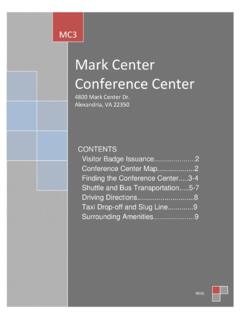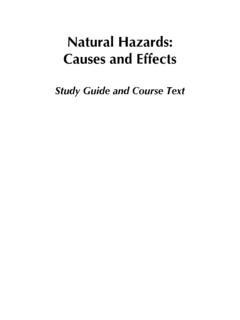Transcription of NATURAL HAZARDS AND DISASTERS ~ HURRICANE …
1 NATURAL HAZARDS AND DISASTERS ~ HURRICANE information 1 HURRICANES - Hurricanes are powerful tropical storms with wind speeds in excess of 74 mph (119 kph). Powerful winds and storm surge can put millions at risk. Even after landfall, hurricanes and tropical storms can produce tornadoes and deadly inland flooding. NOAA is the federal agency charged with forecasting these potentially deadly storms to help protect lives and livelihoods. Hurricanes form in the warm ocean waters near the equator. A HURRICANE has an organized rotation with a central "eye" where the winds are calm. The eye is typically between 20 and 40 miles (32-64 k) in diameter. Surrounding the eye is the eye wall where the winds are usually the strongest and are accompanied by heavy rain. Beyond the eye wall are rain bands, which are long thunderstorms that curve out away from the center of the storm.
2 Damage from hurricanes is caused by the high winds, a powerful storm surge as the storm makes land fall, and inland flooding as an area is saturated with heavy rain. Hurricanes are known as typhoons in the Pacific Ocean and as cyclones in the Indian Ocean. STEM CONNECTION Relating Science and/or Math Concept(s) to Engineering-Engineers address the dangers of hurricanes by designing weather instruments and satellites that detect these storms and predict their paths. Engineers also design structures and sea walls to help people and property survive storms and minimize destruction. Scientists and engineers create mathematical models that help predict when and where hurricanes might hit coastal regions. This information helps save lives by providing warning to citizens so that they can evacuate the area well in advance. Civil engineers further protect residents by building infrastructure, such as levees, to prevent flooding during hurricanes.
3 Furthermore, when civil engineers design roads, buildings and bridges in coastal regions, they must take into account the potential for hurricanes so that their structures can withstand high-force winds. USACE ROLE IN HURRICANE RESPONSE Every year, the Army Corps of Engineers, part of the federal government s unified national response to DISASTERS and emergencies, sends hundreds of people to respond to DISASTERS around the world. USACE has more than 40 specially trained response teams ready to perform a wide range of public works and engineering-related support missions. USACE uses pre-awarded contracts that can be quickly activated for missions such as debris removal, temporary roofing, water and commodities distribution, and generator installation. When DISASTERS occur, USACE teams and other resources are mobilized from across the country to assist our local districts and offices to deliver our response missions.
4 PRIOR KNOWLEDGE demonstrate an understanding of the relationship between Earth s atmospheric properties and processes and its weather and climate compare the composition and structure of Earth s atmospheric layers (including the gases and differences in temperature and pressure within the layers) 2 demonstrate an understanding of the law of conservation of energy and the properties of energy and work demonstrate an understanding of weather patterns and phenomena use mathematical models to represent and understand quantitative relationships GUIDING QUESTIONS 1. What are hurricanes and how do they develop? (Known as tropical cyclones and typhoons, these fierce storms can churn the seas into a violent topography of 50-foot (15-meter) peaks and valleys, redefine coastlines and reduce whole cities to watery ruin). (During HURRICANE season, hundreds of storm systems spiral out from the tropical regions surrounding the equator and between 40 and 50 of these storms intensify to HURRICANE levels).
5 (In the Northern Hemisphere, the season runs from June 1 to Nov. 30, while the Southern Hemisphere generally experiences HURRICANE activity from January to March). (Subsequently, 75 percent of the year, it's safe to say that someone somewhere is probably worrying about an impending HURRICANE ). (A HURRICANE builds energy as it moves across the ocean, sucking up warm, moist tro-pical air from the surface and dispensing cooler air aloft. Think of this as the storm breathing in and out). (The HURRICANE escalates until this "breathing" is disrupted, like when the storm makes landfall. At this point, the storm quickly loses its momentum and power, but not without unleashing wind speeds as high as 185 mph (300 kph) on coastal areas). 2. How do forecasters predict the path of a HURRICANE ? Forecasters analyze various numerical models to predict the path of a HURRICANE .
6 Four times a day, forecasters sift through new model runs from NOAA, the Defense Department, European weather centers, universities, and private companies. Based on their experience with each model and the particular dynamics of a storm, NOAA forecasters weigh the output of the models. 3. What are some of the tools that forecasters use to make their predictions? Geostationary east and west satellites first see the convective factors of a storm brewing, sometimes as early as a small cluster of showers and thunderstorms soon after they form off the west coast of Africa. This satellite stays with the storm from beginning to end. NOAA s polar orbiting satellite (POES) flies over the storm twice a day at a lower altitude, loaded with microwave instruments that provide massive amounts of data, all the way to the ocean s surface. But even more important to analyzing a land falling HURRICANE are the data collected by the Air Force and NOAA HURRICANE hunter aircraft flying through the eye of the storm and NOAA s G-IV jet flying around it.
7 The planes have Doppler radar and microwave technology to dissect the storm, and the dropsondes (tubes of weather instruments attached to a parachute) released from the aircraft send back critical data as they float down to the ocean. 4. How do hurricanes impact the environment? (Heavy rains can cause significant flooding inland, and storm surges can produce extensive coastal flooding up to 40 kilometers (25 mi) from the coastline). (Though their effects on human populations are often devastating, tropical cyclones can relieve drought conditions). (They also carry heat energy away from the tropics and transport it toward temperate latitudes, which may play an important role in modulating regional and global climate). 5. How important are evacuation procedures? Emergency evacuation procedures are important for ensuring the immediate and urgent movement of people away from the threat or actual occurrence of a hazard.
8 Two keys to weather safety are to prepare for the risks and to act on those preparations when alerted by emergency officials. 6. Why do engineers and meteorologists care about hurricanes? (Hurricanes are NATURAL HAZARDS that bring destruction ashore in many different ways. The best defense against a HURRICANE is an accurate forecast that gives people time to get out of its way. Engineers design 3 a variety of extensive equipment for meteorologists to use to detect and track hurricanes and to predict their paths). EDUCATIONAL RESOURCES 1. National Oceanic and Atmosphere Administration (NOAA) 2. National Oceanic and Atmosphere Administration (NOAA) 3. National Oceanic and Atmosphere Administration (NOAA) A poster featuring the water cycle can be found at 4. Integrated Teaching and Learning Program, College of Engineering, University of Colorado Boulder 5.
9 Army Corps of Engineers 6. Federal Emergency Management Agency EDUCATION CONNECTION HURRICANE season begins June 1 and ends November 30. National Oceanic and Atmospheric Administration s Climate Prediction Center is forecasting an active or extremely active season this year. The forecast calls for a 70 percent chance of 13-20 named storms (with top winds of 39 mph or higher), of which seven to 11 will strengthen to a HURRICANE (with top winds of 74 mph or higher) and of those three to six will become major hurricanes (with top winds of 111 mph or higher, ranking Category 3, 4 or 5). As with every HURRICANE season, it is important to have a HURRICANE preparedness plan in place. As the climate changes and the strength and paths of hurricanes also change, it is increasingly important for students to understand hurricanes. This collection provides educators and students with resources to explore how hurricanes form, their potential effects to humans and ecosystems, ways to prepare for hurricanes, and even a citizen science project to classify hurricanes from satellite imagery.
10 Photo Attribution Description: Open hand raised, Stop HURRICANE sign painted Source.














